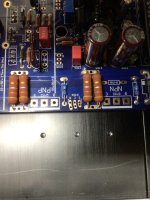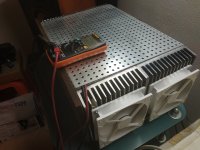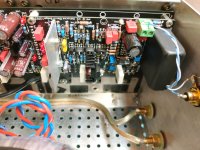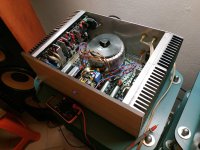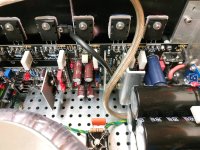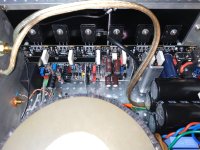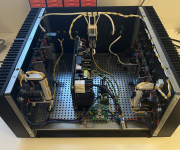This is not the answer. As soon as Q104 has any type of added airflow it's going to cool. This cooling will make your bias circuit go crazy as Q104 itself will be cooled but the heatsinks due to their thermal resistance will not cool at the same rate. If Q104 cools it will try and increase the bias even further and because the fan is on it will just get even cooler. How is it ever going to measure the ambient temperature. This in my opinion is a very poor solution to controlling the temperature of your heatsinks and the stability of your bias.controlled MCU fans
Hi Stuart
If you see my construction of my amp again ..... you will see the fans not evolving at all with the Q104 transistor ....only with outside of the heatsinks. My thinking is more complicated so as to deal with the possibly long dimension of the heatsink but much more the high demands of a large amplifier. Otherwise we will be limited to small amplifiers like USSA-5 and AN 39.. This amplifier Wolverine is "doomed "to play at high acoustic levels .
If you see my construction of my amp again ..... you will see the fans not evolving at all with the Q104 transistor ....only with outside of the heatsinks. My thinking is more complicated so as to deal with the possibly long dimension of the heatsink but much more the high demands of a large amplifier. Otherwise we will be limited to small amplifiers like USSA-5 and AN 39.. This amplifier Wolverine is "doomed "to play at high acoustic levels .
Maybe yours is but everyone who used the correct parts and chassis will be fine.This amplifier Wolverine is "doomed "to play at high acoustic levels .
Hi Nikos,
Hope you are well.
My amps don't have the bias "problem" that you are describing.
This amp has been thoroughly tested by many and it's very stable. We drove Neil and Thimios crazy getting them to change parts daily so we can come up with the optimum values.
Most likely your amp is different because you are using smaller heatsinks and to compensate you use fans.
Your above setup has not been tested by the design team, so it’s unfair to expect an answer/ solution.
Regards
Harry
Hope you are well.
My amps don't have the bias "problem" that you are describing.
This amp has been thoroughly tested by many and it's very stable. We drove Neil and Thimios crazy getting them to change parts daily so we can come up with the optimum values.
Most likely your amp is different because you are using smaller heatsinks and to compensate you use fans.
Your above setup has not been tested by the design team, so it’s unfair to expect an answer/ solution.
Regards
Harry
Question regarding parts placement on EF3-4 V. 4.0
I understand from reading the Wolverine Build Guide revision 41 (07-10-23) that the role of Q104 changed to that of ambient temperature sensor. It is now free standing on the pcb.
But in reviewing my placement of components I see another place on the edge of the board labeled Q104 between some resistors (see photo below). Am I correct that this position like C110, C111 and C120) is no longer used? The last photo in the Build Guide shows a picture of the board without that location populated. If that is so, just leave it unpopulated?
Many thanks,
John
I understand from reading the Wolverine Build Guide revision 41 (07-10-23) that the role of Q104 changed to that of ambient temperature sensor. It is now free standing on the pcb.
But in reviewing my placement of components I see another place on the edge of the board labeled Q104 between some resistors (see photo below). Am I correct that this position like C110, C111 and C120) is no longer used? The last photo in the Build Guide shows a picture of the board without that location populated. If that is so, just leave it unpopulated?
Many thanks,
John
Attachments
Im fine Harry. Thank you .Hi Nikos,
Hope you are well.
The same thing is happening with mine now ( not runaway the temp or bias after moving transistor Q104My amps don't have the bias "problem" that you are describing.
This amp has been thoroughly tested by many and it's very stable.
its not so small Harry . Small are they if play the amp at high acoustic levels and Q104 does not get correct reference.you are using smaller heatsinks
its true ... the above setup with controlled MCU fans acting like a big heatsink keep the temp and the bias rock steady with more safety for the output transistors especially at high levels .Your above setup has not been tested by the design team
Υes, I was late to understand it. It's like losing the machine's warranty if you touch it inside....so it’s unfair to expect an answer/ solution.
Regards my friend Harry.
Attachments
I will give you an extended warranty period.
On a serious note I am not sure what is happening when your heatsink gets hot and then the fan suddenly cools it. Someone with better knowledge might be able to analyse your setup.
On a serious note I am not sure what is happening when your heatsink gets hot and then the fan suddenly cools it. Someone with better knowledge might be able to analyse your setup.
Yes, I only accept it from you.I will give you an extended warranty period.
On a serious note I am not sure what is happening when your heatsink gets hot and then the fan suddenly cools it. Someone with better knowledge might be able to analyse your setup.
Τhe heatsinks do not receive a thermal shock, the fans start working at 40 degrees with very low revolutions since you can adjust in steps, they dissipate the temperature thus keeping the bias constant even at high levels, especially when you have 4 Ω speakers.
Now, in my turn, I urge the members who have built this amplifier to provide measurements of the bias and the temperature of the heatsinks at specific ambient temp at high level if they want of course, and if they have done so....
I'm pretty sure it will be around 55 C degrees here at high acoustics levels with classics heatsinks and the bias more lower than 40mv..
How much can a continuous reduced bias current affect the performance in audio quality?
Last edited:
We all used the same materials, others of higher quality, others a little lower....and these materials do not determine the following comments:Maybe yours is but everyone who used the correct parts and chassis will be fine.
When I say doomed to play at high acoustic levels , I'm talking about the design of this amplifier of the output in watts, the amplifier plays very well in terms of power output and very cleanly at high levels , BUT without color it is a neutral amplifier.
This is my personal opinion after many hours listening with different amps with the same setup.
Attachments
Continuously decreasing bias is literally a function of having not enough heat dissipation ability in your heatsinks in the given ambient environment. Not a criticism, it is just reality.
Neutral sound is also not a surprise considering how low the measured distortion is. The idea is to reproduce the music without colouration or distortion.
If you want a coloured sound then consider building an amp with more colouration or use tubes or DSP in your preamp for example.
Hope this info helps.
- Dan
Neutral sound is also not a surprise considering how low the measured distortion is. The idea is to reproduce the music without colouration or distortion.
If you want a coloured sound then consider building an amp with more colouration or use tubes or DSP in your preamp for example.
Hope this info helps.
- Dan
Dan
Of course helps others...
I dont have problem any more with heat dissipation ability in my heatsinks, i solve it with MCU fan in all low and high acoustics levels range....
i hope all others if play at high levels to have no problem with classic heatsinks and keep the performance and bias rock steady especially at 4 Ω.
Of course helps others...
I dont have problem any more with heat dissipation ability in my heatsinks, i solve it with MCU fan in all low and high acoustics levels range....
i hope all others if play at high levels to have no problem with classic heatsinks and keep the performance and bias rock steady especially at 4 Ω.
Let me imagine that you are not a fan of Monotonic decrease harmonics profile amplifiers.Neutral sound is also not a surprise considering how low the measured distortion is. The idea is to reproduce the music without colouration or distortion
I have played around with plenty of class A amplifiers with this sort of harmonic profile, Hiraga - tube and solid state, Pass, JLH etc etc. it is alot of fun but these days I like to keep the distortion down hence building the Wolverine 🙂
So do you like the sound of the Wolverine Nikos ?
I personally do because I find it is just music without excess thd and noise.
Also for what it is worth I do think you did a good job on your build and if you have good control over your fans there is no issue with that
-Dan
So do you like the sound of the Wolverine Nikos ?
I personally do because I find it is just music without excess thd and noise.
Also for what it is worth I do think you did a good job on your build and if you have good control over your fans there is no issue with that
-Dan
I really like this amp for what it is designed to do. Neutral sound, very clear sound even at high volumes...
Besides, the demand for its construction in the community and not only says it all.
I'm actually a fan of class A, everything is more colorful and detailed.
I think I'm getting old hahaha.
Besides, the demand for its construction in the community and not only says it all.
I'm actually a fan of class A, everything is more colorful and detailed.
I think I'm getting old hahaha.
These are my amps - preamps.
Attachments
-
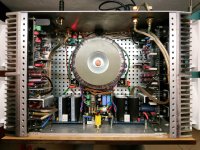 IMG_20231129_191831(1).jpg545.6 KB · Views: 110
IMG_20231129_191831(1).jpg545.6 KB · Views: 110 -
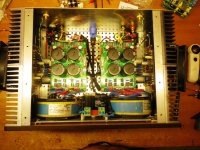 IMGP0285.jpg578.3 KB · Views: 107
IMGP0285.jpg578.3 KB · Views: 107 -
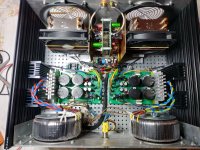 IMG_20241004_211801.jpg727.4 KB · Views: 104
IMG_20241004_211801.jpg727.4 KB · Views: 104 -
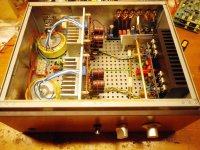 IMGP0273.JPG727.3 KB · Views: 106
IMGP0273.JPG727.3 KB · Views: 106 -
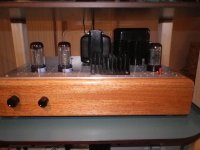 IMGP0008.JPG421.1 KB · Views: 102
IMGP0008.JPG421.1 KB · Views: 102 -
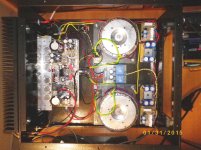 IMGP0026.jpg555.8 KB · Views: 106
IMGP0026.jpg555.8 KB · Views: 106 -
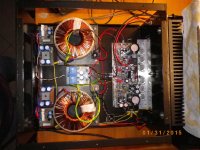 IMGP0025.jpg555.8 KB · Views: 109
IMGP0025.jpg555.8 KB · Views: 109 -
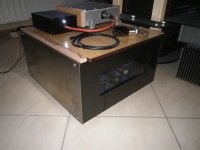 IMGP0001-1.JPG313.5 KB · Views: 107
IMGP0001-1.JPG313.5 KB · Views: 107
Hi John,But in reviewing my placement of components I see another place on the edge of the board labeled Q104 between some resistors (see photo below). Am I correct that this position like C110, C111 and C120) is no longer used? The last photo in the Build Guide shows a picture of the board without that location populated. If that is so, just leave it unpopulated?
Your correct the edge mount for Q104 is no longer required or recommended to use now that Q104 is the ambient temperature sensor.
Where you currently have Q104 is correct.
Hello, I have a question regarding C121, 122, 125, 126. I have the 3-4 4th group buy board. It looks like there are some options here. Any pro's or cons to condider? Does the electrolytic capacitor get installed on top of the surface mount for the preferred option on the BOM? Any info greatly appreciated. Thanks.

Wired my Wolverine today and gave it the first listen. And wow, not sure if it's because of all the work that have gone into it, but it sounds really good on my not so fancy speakers. The sound feels very controlled and yet with lots of power (and now i will use no more meaningless audiophile jargon 🙂 ).
It was difficult to finalize on a good wiring scheme, especially since i have no skills whatsoever in working with metal (nor any tools), making it difficult to create new mounting points for wires. I do however have a 3D printer, so i printed some plastic wire "bridges" in ASA plastic. The result might be kind of stupid, but it works pretty well.
My fairly sensitive speakers are nearly dead quiet when the amp is on, except for the faintest buzz when i have my ear pretty much touching the tweeter of the left speaker. I have a feeling it might be due to the sub-optimal placement of the left input wire right next to the output of the right channel. I will have to optimize the wiring a bit before finally putting the top lid on it, but it's difficult to stop the music and unplug it from the wall.
All in all, for those currently building one, you should be very excited to hear it when it's done 🙂


It was difficult to finalize on a good wiring scheme, especially since i have no skills whatsoever in working with metal (nor any tools), making it difficult to create new mounting points for wires. I do however have a 3D printer, so i printed some plastic wire "bridges" in ASA plastic. The result might be kind of stupid, but it works pretty well.
My fairly sensitive speakers are nearly dead quiet when the amp is on, except for the faintest buzz when i have my ear pretty much touching the tweeter of the left speaker. I have a feeling it might be due to the sub-optimal placement of the left input wire right next to the output of the right channel. I will have to optimize the wiring a bit before finally putting the top lid on it, but it's difficult to stop the music and unplug it from the wall.
All in all, for those currently building one, you should be very excited to hear it when it's done 🙂
Attachments
- Home
- Amplifiers
- Solid State
- DIY Class A/B Amp The "Wolverine" build thread
